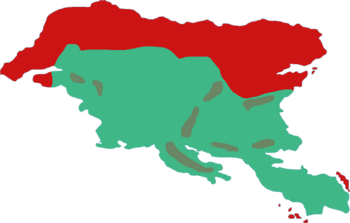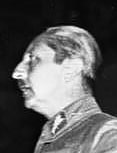Tymzar–Nalo regime
Kingdom of Xevden | |||||||||
|---|---|---|---|---|---|---|---|---|---|
| 1947–1958 | |||||||||
| Motto: Everything for Victory | |||||||||
 Territory held by the Tymzar–Nalo regime (green) at its height in 1948 | |||||||||
| Capital | Velouria | ||||||||
| Government | Political Futurist one-party absolute monarchy | ||||||||
| King | |||||||||
• 1947-1958 | Tymzar | ||||||||
| Leader | |||||||||
• 1947-1958 | Nalo Ðari | ||||||||
| Historical era | Liberation War | ||||||||
| 31 December 1947 | |||||||||
| 2 January 1958 | |||||||||
| |||||||||
| Today part of | |||||||||
Part of a series on the |
|---|
| History of Gylias |
 |
The Tymzar–Nalo regime is the common term for the totalitarian regime that ruled Xevden during the second phase of the Liberation War. The term comes from its leading figures: king Tymzar and leader Nalo Ðari, who served as head of government.
The regime seized power through a coup d'état on 31 December 1947, destroying the Nerveiík Kingdom in the process. It was organised as a one-party state centred around Nalo's Revolutionary Front for Patriotic Victory. It implemented totalitarian policies to achieve "national mobilisation" and a victory in the Liberation War.
A general offensive was launched in February 1948, and the regime initially scored easy defeats against the fractious Gylian forces and advanced northwards. However, they floundered against the Free Territories' prudent strategy and mastery of guerrilla warfare.
Victories by the People's Army at the battles of Nerazur and Mytin on 14–15 April 1948 were disastrous for the regime, which lost the initiative. The rest of the war saw its slow collapse against the Free Territories' methodical advance, until its final defeat in the Battle of Velouria on 2 January 1958.
Name
Theoretically, the name of the state remained the "Kingdom of Xevden". However, due to its destruction of the Nerveiík Kingdom and role in the second phase of the Liberation War, it is usually referred to as the "Tymzar–Nalo regime", after its two main leaders.
The phrasing reflects an adversary–enemy distinction, with "regime" used to emphasise its monstrous nature, in contrast to the respect afforded to the Nerveiík Kingdom as an honourable adversary. Additionally, the use of "Tymzar–Nalo regime" places it as the last and highest stage of Xevdenite oppression.
Formation
During the first phase of the Liberation War, Xevden's withdrawal to Nerveiík resulted in the formation of the Nerveiík Kingdom. Under the tutelage of the ruling Varnaþ family, the kingdom continued on the course set by the 1400 Days' Reform, developing into a precariously stable constitutional monarchy, which sought to achieve both international recognition and negotiate an end to the Liberation War.
While the kingdom gained the Gylian factions' respect due to the Varnaþ family's sincere commitment to peace and reform, it remained dependent on foreign support to prop up its economy and reorganise its National Army and Royal Guard.
The main threats to the kingdom came from two major currents: the reactionaries, who simply desired the restoration of absolute monarchy and overturning the Gylian ascendancy, and the Political Futurists. The latter, organised in the Revolutionary Front for Patriotic Victory, built on the social spencerism and racism of the ancien régime to advocate a totalitarian and genocidal project to "cleanse" Xevden of Gylians and achieve a "national rebirth". The RFPV's paramilitary arm, the Storm of Steel, became infamous for its brutality and attempts to provoke fights with superior Gylian forces on the border.
Although hostile to each other, the reactionaries and RFPV ultimately coalesced into a "monstrous alliance" and seized power in a coup d'état on 31 December 1947. The coup marked the end of the Nerveiík Kingdom. Láaresy was imprisoned by the regime while the rest of the Varnaþ family escaped to Daláyk. Tymzar took the throne, launching a purge on the occasion that killed or imprisoned anyone at the palace associated with the former Nerveiík Kingdom.
Politics
The regime was a totalitarian absolute monarchy. Tymzar was its king, while the head of government was Nalo Ðari, who simply took the title "Leader". The legislature was abolished and all other parties were disbanded by force, and a severe assault on civil rights was unleashed.
In their zeal to destroy enemies and achieve complete state control, the Futurists also dissolved the court system, replacing it with so-called "national courts" which were essentially kangaroo courts and invariably handed out sentences of death, imprisonment, or torture.
Foreign relations
With the destruction of the Nerveiík Kingdom's attempts to achieve diplomatic recognition, Xevden sank into its worst stage of international ostracism. The regime cared little for foreign policy, and in any case its brutal conduct so repulsed international opinion as to make diplomacy essentially impossible.
The regime was supported by Æþurheim's Futurist dictatorship, and at some points benefited from support from other authoritarian right-wing regimes like the Empire of Quenmin. Its strident anti-communism and authoritarianism attracted some far-right volunteers from abroad to its cause, but nowhere near the fame and sympathy for the International Brigades.
The nature of the regime even drove some powers like Acrea to reluctantly support the Free Territories as a preferable alternative.
Economy
The regime took the corporatist economic policies of the Nerveiík Kingdom in a totalitarian direction, based on state control of the economy, planning, and national syndicalism. Strikes were banned, and the National Syndical Organisation was taken over and subordinated to the state. The National Bank was reduced to a single imperative: to supply the Xevdenite war machine with money.
The drive to mobilise all of society for war produced great deprivations and abuses for the majority. The regime undid the Nerveiík Kingdom's progressive policies, increased working hours, reduced pay, and allowed workers' purchasing power to be eroded by inflation, resulting in widespread poverty and exploitation.
Ideology
At its foundation, the regime was an uneasy partnership between reactionaries and Political Futurists. The reactionaries detested modernity and embraced traditionalism. They had no program beyond simply seeking to destroy what they hated, and were essentially appeased with Tymzar's seizure of power and subsequent authoritarianism. Due to this ideological void, many reactionaries were convinced to go along with the Futurists' vision and program out of convenience.
The Futurists, on the other hand, rejected the past and championed a harsh vision of modernity, exalting violence and youth, and praising war as "the world's only hygiene". They scorned the "weakness" of democracy, liberalism, and egalitarianism. This allowed them to pick up on the racism and social spencerism that the Xevdenite elites developed as justifications for minority rule during the Gylian ascendancy, and take them to their horrifying logical conclusion: a palingenetic ultranationalism in service of a totalitarian vision of a strictly regimented, corporatist society mobilised behind a distorted interpretation of modernity.
Several historians noted the irony that the regime's fierce ethnocentrism and desire to "cleanse" Xevden of Gylians actually made enemies of the former Futurist Party of Alscia followers and Gylicists, turning what would've been obvious far-right partners into bitter enemies. In her study of the Free Territories, Sofia Westergaard mockingly observed, "The Gylicists and Naloites virtually agree on everything but who should be on top of this horrifying idea of society."
The reactionaries' patriarchal vision and the Futurists' obsession with violence coalesced into a strongly misogynist ideology. The Futurists celebrated "virility" as a measure of a man's worth; the reactionaries seized the opportunity to unravel the reforms of the Nerveiík Kingdom. The oppression of women directly caused one of the regime's biggest humiliations when the entire Royal Guard defected in 1948 and joined Lidia's Legion.
The RFPV stood out even among Tyranian far-right formations for its obsession with violence and self-sacrifice, raised to the level of national mysticism. The most infamous manifestation of this obsession was its paramilitary wing, the Storm of Steel, which gained a reputation for fanaticism and brutality. The regime's attempts to inculcate relentless violence and "dynamism" meant that its authoritarianism mainly came in the form of chaotic extrajudicial killings, with little of the systematic attempts to crush dissent of other Tyranian dictatorships.
Symbolism
The uneasy compromise between reactionaries and Futurists was reflected in the official state symbolism. The "Kingdom of Xevden" remained, and the old pre-1938 flag with the coat of arms was restored. At the same time, the state adopted a new coat of arms, depicting an eagle holding a sword and two lightning-shaped arrows in its claws.
Military
Although the regime inherited a modern and well-equipped professional army from the Nerveiík Kingdom, it essentially threw this advantage away. The National Army was transformed into the Royal Army through a hasty purge and reorganisation, causing chaos in its ranks. The loss of international support after the Nerveiík Kingdom's overthrow forced Xevden to rely principally on Æþurheim for supplies and equipment.
War and collapse
The regime launched a general offensive in February 1948, beginning the second phase of the Liberation War. The Royal Army advanced northwards, achieving easy defeats of fractious Gylian forces. However, they met their match in the Free Territories, floundering against the People's Army's superior prudent strategy and mastery of guerrilla warfare.
Impatient and meddlesome, Tymzar and Nalo pushed for relentless offensives, seeking to deal a death blow to the Free Territories. Instead, the Royal Army suffered spectacular defeats at the battles of Nerazur and Mytin on 14-15 April 1948.
The defeats, international isolation, and defection of the Royal Guard proved catastrophic for the regime. Worse, its decimation of the other factions drove them to unite behind the Free Territories, turning the war into a straightforward conflict. It never regained the initiative, and the rest of the war marked its death throes, as it slowly retreated in the face of the People's Army.
The defeats of Nerazur and Mytin and the slow collapse triggered a process of cumulative radicalisation in the RFPV and Storm of Steel. They launched the Xevdenite Terror, a campaign of destruction and massacres that lasted throughout the second phase of the war.
Tne end finally came with the Battle of Velouria, in which the People's Army prevailed on 2 January 1958. Tymzar and Nalo were captured alive, and received the harshest sentences at the Arnak Trials.
Legacy
The Tymzar–Nalo regime stands out as the principal far-right dictatorship of Gylian history. Its savagery contributed to the length and traumatising violence of the Liberation War, while its figureheads' public punishment in the Arnak Trials contributed to post-war catharsis, the necessary destruction of the old regime that preceded the transition to Gylias and subsequent Golden Revolution.
Nalo in particular was humiliated even in death: the anarchists' adroit propaganda reduced him to a pompous and stupid figure of ridicule. His relentless caricaturing in Gylian pop culture served to both accentuate the criminal nature of the Tymzar–Nalo regime and its irrational ludicrousness. Its universal perception as both monstrous and laughable thwarted attempts at misplaced admiration.
The late liberation of southern Gylias and the traumatic experience of the Tymzar–Nalo regime shaped its politics by steering it towards a more conservative and practical mindset, with suspicion of utopian schemes due to the hard-learned lesson of how easily idealism can transform into totalitarian fanaticism.
The regime's exaltation of violence and assault upon institutions also contributed to a collapse of rule of law and a growth in criminal activity during its drawn-out collapse, allowing formations like the Mava Organisation to establish themselves.



